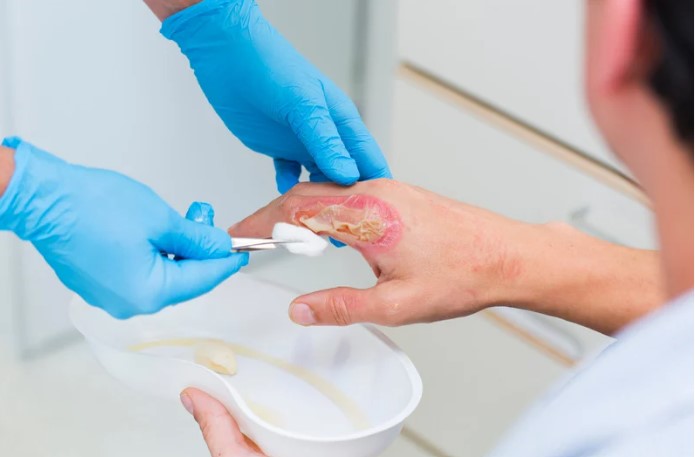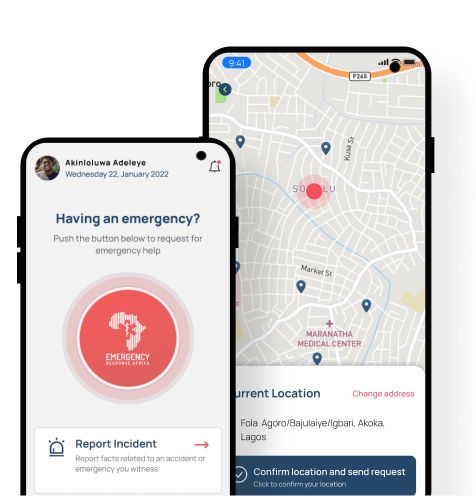Burn injuries are common medical emergencies affecting thousands of people yearly.
The World Health Organization (WHO) reports that burns account for an estimated 180,000 deaths annually, with most cases occurring in low- and middle-income countries, including Nigeria.
In homes, workplaces, and public spaces, burns result from flames, hot liquids, chemicals, and electrical accidents, and it can affect both children and adults.
Many burn victims in Nigeria receive improper first aid, such as applying raw eggs, toothpaste, or oil, which can worsen pain, increase infection risk, and delay healing. Without the right treatment, even minor burns can lead to severe complications, including permanent scarring and disability.
This article gives clear, step-by-step instructions on how to handle various types of burns, equipping you with essential knowledge to provide quick relief and know when to call for professional help.
What Are Burns?
According to the World Health Organization (WHO), burns are “injuries to the skin or other organic tissue primarily caused by heat or due to radiation, radioactivity, electricity, friction, or contact with chemicals.”
The skin itself is made up of three main layers. Burns can affect the outer layer and, in severe cases, reach deeper layers. This can cause pain, swelling, and possible infections.
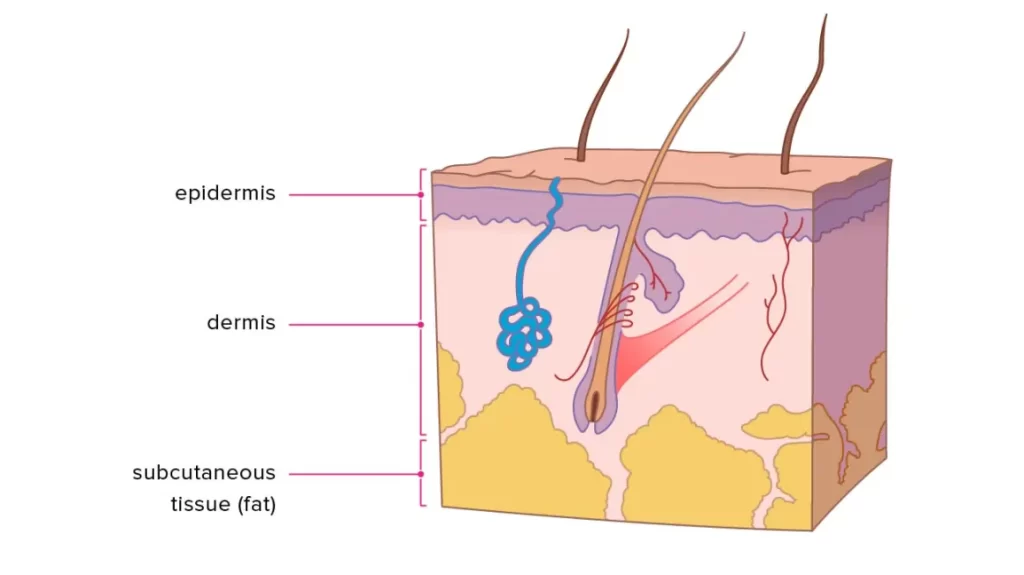
- Epidermis (outer layer) – The outermost layer that shields the body from infection and dehydration
- Dermis (middle layer) – Contains nerve endings, blood vessels, and hair follicles.
- Hypodermis (deepest layer) – Made up of fat and connective tissues that provide insulation and cushioning.
The severity of a burn depends on how deep it penetrates these layers, which determines the type of burn and the appropriate treatment.
Types of Burns and Their Severity
Burns are classified based on the depth of skin layer damage, ranging from minor injuries to life-threatening conditions. While first-degree burns heal quickly, severe burns can cause permanent tissue damage and require urgent medical care. Understanding burn severity is crucial for effective treatment and reducing complications.
First-Degree Burns (Superficial Burns)
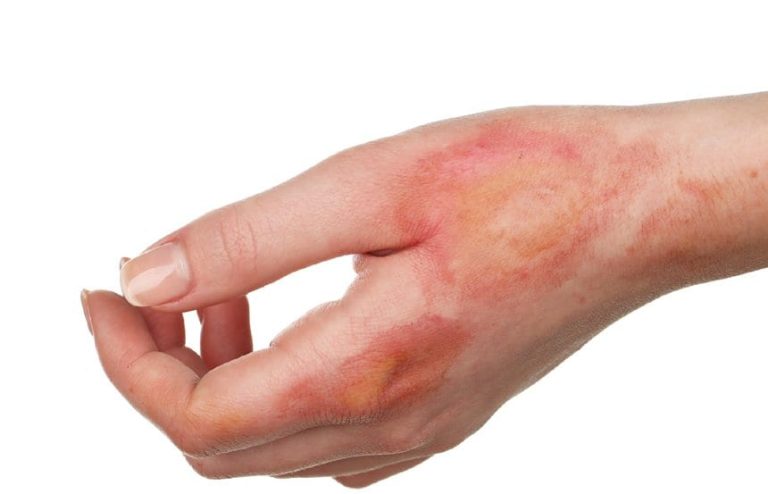
These are the mildest types of burns, affecting only the epidermis, the outermost layer of the skin. They cause redness, minor swelling, and pain but do not form blisters. Since the skin barrier remains intact, healing typically occurs within 7 to 10 days without scarring.
Likely Causes
- Sunburn from prolonged UV exposure
- Brief contact with hot objects like a stove or iron
- Scalding from mildly hot liquids
- Minor chemical burns from mild irritants like household cleaning agents
Symptoms
- Red, inflamed skin
- Mild swelling
- Dry and peeling skin during healing
Treatment
- Run cool water over the burn for at least 5 minutes
- Apply aloe vera gel or lidocaine cream to soothe pain
- Use an antibiotic ointment and cover with loose gauze
- Take acetaminophen or ibuprofen for pain relief
First-degree burns rarely require medical attention unless they cover a large area or affect sensitive regions like the face, joints, or genitals.
Second-Degree Burns (Partial-Thickness Burns)
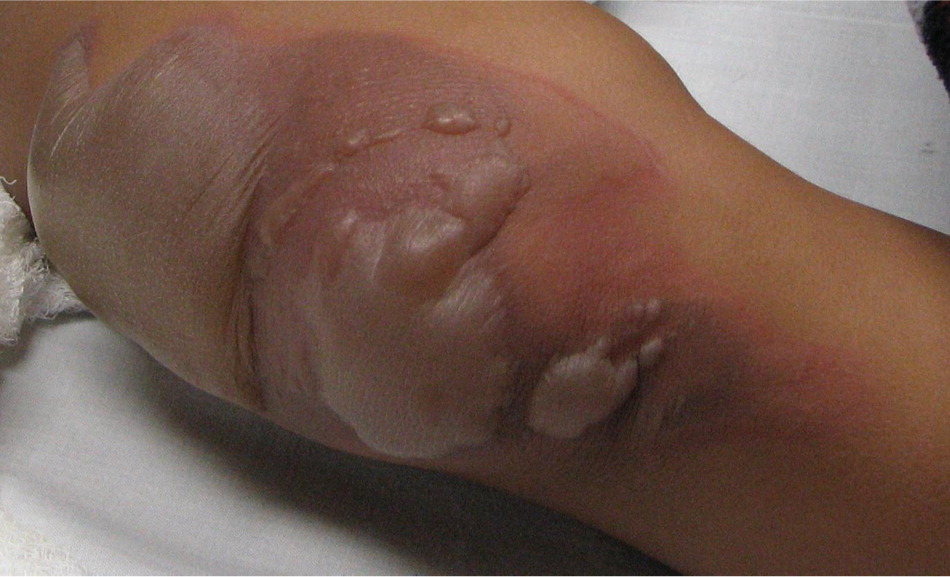
Second-degree burns penetrate beyond the epidermis into the dermis, the skin’s middle layer. These burns are more painful and form fluid-filled blisters. The affected area may appear red, swollen, and moist. In severe cases, thick, scab-like tissue called fibrinous exudate may develop. Healing time varies between 2 to 3 weeks, and pigment changes may occur even after recovery.
Likely Causes
- Scalding from boiling water, oil, or steam
- Direct flames from matches, candles, or stoves
- Electrical burns from faulty appliances or power surges
- Chemical exposure to strong acids or alkalis (e.g., bleach or drain cleaners)
- Friction burns from motorcycle or bicycle accidents
Symptoms
- Blisters that may pop, leaving a wet wound
- Intense redness and swelling
- Severe pain and sensitivity to touch
Treatment
- Rinse the burn under cool running water for 15 minutes
- Avoid breaking blisters to prevent infection
- Apply antibiotic creams and cover with a sterile dressing
- Take pain relievers to manage discomfort
Medical attention is needed if the burn covers a large area or affects sensitive areas like the face, hands, groin, or feet.
Third-Degree Burns (Full-Thickness Burns)
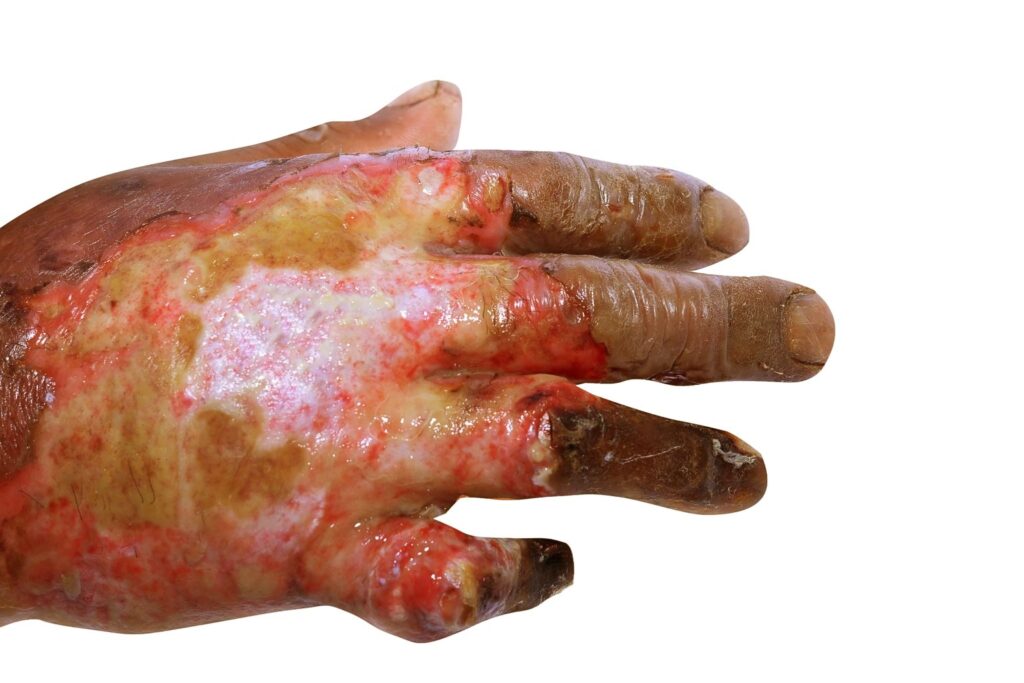
These burns extend through the dermis into the hypodermis (deepest layer), destroying nerve endings, blood vessels, and tissues. The burned area may appear white, charred, or leathery, and victims may feel little to no pain in the burned area due to nerve damage. Third-degree burns require immediate emergency care, as they can lead to severe complications like infections, dehydration, or shock. These burns do not heal on their own and often require skin grafting.
Likely Causes
- Prolonged exposure to open flames (house fires, explosions)
- Severe electrical burns from high-voltage shock
- Chemical burns from industrial acids or corrosive substances
- Prolonged contact with hot metals, glass, or coals
Symptoms
- White, leathery, or charred skin
- Lack of pain due to nerve destruction
- Blisters do not develop
Treatment
- Do not apply water or home remedies
- Cover with a clean, dry cloth
- Seek emergency medical attention immediately
Without surgery, third-degree burns heal with severe scarring and contractures, limiting movement in affected areas.
Fourth-Degree Burns (Life-Threatening Burns)
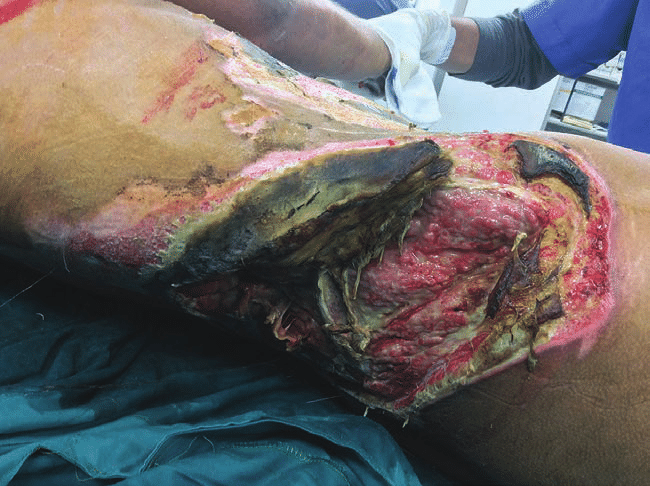
The most severe type, fourth-degree burns extend beyond the skin layers into muscles, tendons, and bones. These burns are life-threatening and often require amputation or reconstructive surgery. Victims may suffer from organ failure, shock, or fatal infections. Immediate emergency medical care is critical.
Likely Causes
- Severe electrical burns from power lines or lightning strikes
- Explosions involving flammable materials
- Prolonged exposure to extreme heat (fire-related accidents)
- Industrial accidents involving molten metals or chemicals
Symptoms
- Blackened, charred skin
- Exposure of bone or muscle
- Complete loss of sensation
Treatment
- Call emergency services immediately
- Do not attempt first aid beyond covering the area with a clean, dry cloth
- IV fluids, antibiotics, and possible surgical intervention are required.
Practical First Aid for Burns in Nigeria
Burn injuries cause major losses in Nigeria, with over 2,000 fire incidents recorded in 2022 and property damage exceeding one trillion naira.
These numbers show the urgent need for everyone to learn practical first aid for burns, whether from a small kitchen accident or a serious industrial fire. Acting quickly can reduce skin damage, prevent infections, and even save lives.
The table below outlines the best first aid actions based on burn severity:
| Burn Type | First Aid Actions |
| Minor Burns (First-Degree Burns) | Run cool water over the burn for at least 5 minutes |
| Apply aloe vera gel or honey to soothe pain | |
| Cover with a light, breathable dressing | |
| Take over-the-counter pain relievers if needed | |
| Severe Burns (Second & Third-Degree Burns) | Cool the burn with running water for 15 minutes (for second-degree burns only) |
| Avoid breaking blisters to prevent infection | |
| Cover with a sterile, non-stick bandage | |
| Dial 112 or call ERA for urgent medical attention | |
| Scalds (Burns from Hot Liquids or Steam) | Remove wet clothing, but avoid pulling off skin-stuck fabric |
| Cool the affected area with running water | |
| Apply a sterile dressing, but avoid ointments | |
| Monitor for signs of infection and seek medical help if scald covers a large area or is very painful | |
| Chemical Burns | Rinse the affected area with large amounts of running water for 20 minutes. |
| Remove contaminated clothing or jewelry. | |
| Avoid neutralizing chemicals (e.g., using vinegar on an alkaline burn) | |
| Call ERA or 112 if burn is deep or widespread | |
| Electrical Burns | Ensure the victim is no longer in contact with electricity before touching them. |
| Call emergency services immediately, as internal injuries may not be visible | |
| Check breathing and perform CPR if necessary. | |
| Cover burns with a dry, sterile dressing. |
Home Remedies and Safe Practices for Mild to Moderate Burns
After addressing the immediate first aid needs, certain home remedies can help soothe pain and support faster recovery for mild to moderate burns. These methods should only be used when the burn isn’t extensive, blistering severely, or showing signs of infection.
- Aloe Vera Gel: Aloe vera has cooling and anti-inflammatory properties that may ease discomfort and reduce swelling. Apply a thin layer of pure aloe vera gel over the burn, ensuring the skin is clean beforehand.
- Honey Applications: Honey has natural antibacterial qualities, which can help prevent infection in shallow burns. Spread a small amount on sterile gauze and cover the burn. Change the dressing regularly to keep the area clean.
- Cool Compresses: Placing a cool, damp cloth on the burn helps draw out heat and relieve pain. Dip a cloth in clean, cold water (not ice water) and gently press on the burn. Replace or re-wet when it warms up.
- OTC Pain Relievers: Over-the-counter medications like ibuprofen or paracetamol help ease inflammation and pain. Follow dosage instructions on the label. If pain persists, consult a healthcare professional.
- Hydration and Nutrition: Staying hydrated and eating nutrient-rich foods support skin regeneration and speed up recovery. Drink plenty of water and include vitamins (especially vitamins C and E) in your meals.
Note: These remedies are best suited for first-degree or minor second-degree burns. If the burn shows signs of infection (e.g., redness, swelling, foul odor) or covers a large area, consult a medical professional immediately. In serious cases, reach out to Emergency Response Africa (ERA) or dial 112 for expert care.
When to Seek Professional Help
Seek expert medical care right away if you notice any of the following:
- Large or Deep Burns: Third-degree or any burn covering a significant area of skin.
- Burns on Critical Areas: Face, hands, feet, genitals, or major joints.
- Signs of Infection: Spreading redness, foul odor, pus, or fever.
- Electrical or Chemical Burns: Risk of hidden internal damage, requiring specialized treatment.
Contact Emergency Response Africa (ERA) or dial 112 for urgent assistance. Prompt professional attention prevents complications like shock or permanent scarring, ensuring the best possible outcome.
Things Not to Do When Handling Burn Injuries
Even the best intentions can lead to complications if you use inappropriate methods. To avoid worsening a burn or increasing infection risk, keep these common mistakes in mind:
- Do Not Apply Ice Directly: Ice can damage skin tissue further. Use cool water or a cool compress instead.
- Avoid Harmful Substances: Toothpaste, raw eggs, oils, and other unverified substances may trap heat and introduce bacteria into the wound.
- Do Not Break Blisters: Blisters act as a natural barrier against germs and popping them would expose the wound to infection and prolongs healing.
- Never Ignore Serious Burns: Attempting home treatment on severe second-degree, third-degree, or chemical burns can lead to life-threatening infections or shock.
- Neglecting Proper Dressing Care: Using dirty or fluffy materials increases the risk of infection and fibers getting stuck in the wound. Use clean, sterile bandages.
Conclusion
Burns can happen suddenly and often have serious consequences, particularly when not treated properly. When you understand the different burn types, know how to administer immediate first aid, and when to seek professional help, you greatly improve a victim’s chances of a speedy recovery.
Instead of using ineffective home remedies like toothpaste or raw eggs, follow proven first-aid steps to cool the burn, protect the skin, and prevent infections.
For severe burns or life-threatening situations, immediate medical attention is critical. Emergency Response Africa provides rapid emergency care across Nigeria. Call ERA’s emergency hotline for immediate help.

